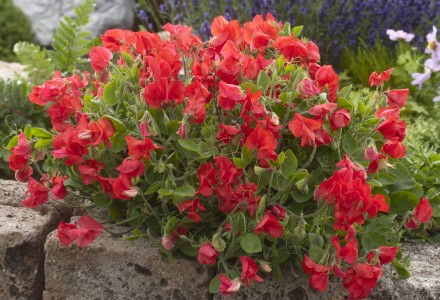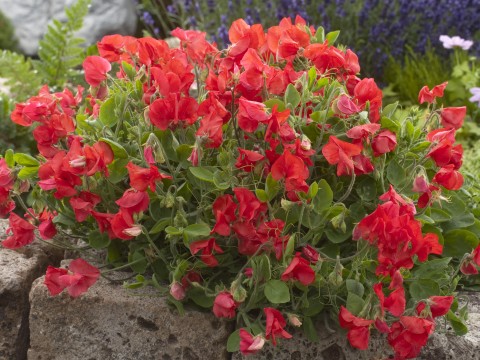'Villa Roma Scarlet' is the first Lathyrus odoratus to win the coveted Fleuroselect Gold Medal, impressing the twenty Fleuroselect European judges with its innovative, striking, bright colour, its overall attractiveness and its excellent garden performance. Flowering profusely from July to September this American-bred, scarlet beauty stands out as is the new empress in compact sweet peas.
USE '
Villa Roma Scarlet' is an excellent addition to the current range of compact, Lathyrus odoratus. The variety is suitable for both professional and consumer use for container gardening, hanging baskets and for full-ground direct sowing. For plug production the variety can be sown as early as January and for direct sowing in the garden from April/May. The variety requires no staking or trellis work and flowers profusely and efficiently from July to September.
MARKET VALUE
With the advent of modern container gardening, compact sweet peas have risen to new heights of popularity. 'Villa Roma Scarlet' with its striking, single colour, the most recent addition to contemporary, compact Lathyrus is earlier than existing varieties, a real plus for the professional Lathyrus grower. Containers of sweet peas are instant gardens and a striking container of these scarlet beauties will provide garden centres with high added retail value. Expert consumers will be able to purchase seed through the amateur packet seed market for home-sown success, while regular gardening enthusiasts can choose ready-made plugs or finished plants for home-grown gratification.
BACKGROUND INFORMATION
Lathyrus odoratus more commonly known as the sweet pea is nicknamed the Queen of Annuals. A flowering plant in the genus Lathyrus from the family Fabaceae (legumes), it is native to the eastern Mediterranean region from Sicily east to Crete. Although sweet peas have been cultivated since the 17th century for the colour and sweet odour from which their name stems, they rose to the height of fashion in the late 19th Century. Morphologically, an individual bloom consists of three or four flowers (or florets) on a stem and varieties can be classified as tendril or non-tendril. Famous names are connected with these royal flowers. More than a hundred years ago Henry Eckford hybridized and selected sweet peas for their best characteristics and introduced the revolutionary grandifloras. Many of his offspring are still commercial available today. The gardens of the Earl of Spencer were meanwhile home to the mutant, which gave birth to the multiflora Spencer types with their ruffled standard (upper petal) and long wing (lower petals). The first original dwarf sweet pea 'Cupid' was bred in the new world from a sport spotted by C.C. Morse of California and introduced in 1895 by W. Atlee Burpee. Other erect dwarf forms originated at about the same time in Europe and were bred in Germany and the U.K. With the growth of modern container gardening there has been a revival in the interest for these compact, dwarfer types and 'Villa Roma Scarlet' is a true and valuable addition to this group. Fleuroselect was delighted to be given the opportunity to test a range of new, compact sweet peas at its European trials in both 2008 and 2009 with the gorgeous 'Villa Roma Scarlet' standing out as the best breakthrough for its spectacular, single, scarlet colour.




